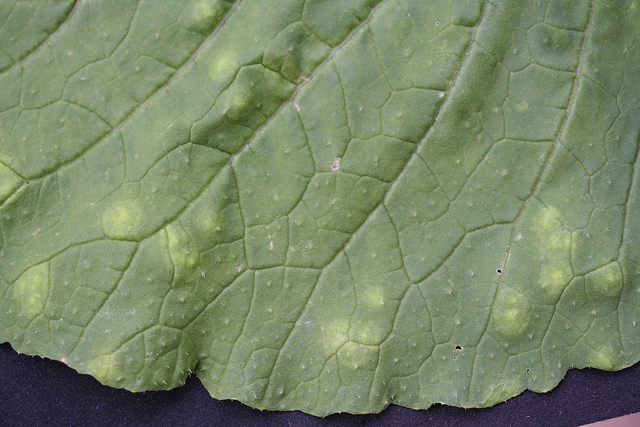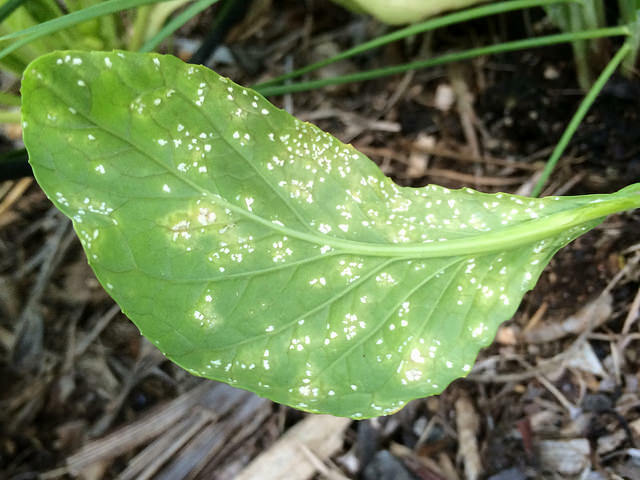Mustard
Description
Uses
Propagation
References
Common Pests and Diseases
Diseases
Category : Fungal
Alternaria leaf spot (Black spot, Gray spot) Alternaria brassicae
Symptoms
Small dark spots on leaves which turn brown to gray; lesions may be round or angular and may possess a purple-black margin; lesions may form concentric rings, become brittle and crack in center; dark brown elongated lesions may develop on stems and petioles
Cause
Fungi
Comments
May become a problem on cabbage during cool, wet periods
Management
Plant only pathogen-free seed; rotate crops; applications of appropriate fungicides control disease when presentClubroot Plasmodiophora brassicae
Symptoms
Slow growing, stunted plants; yellowish leaves which wilt during day and rejuvenate in part at night; swollen, distorted roots; extensive gall formation
Cause
Fungus
Comments
Can be difficult to distinguish from nematode damage; fungus can survive in soil for periods in excess of 10 years; can be spread by movement of contaminated soil and irrigation water to uninfected areas
Management
Once the pathogen is present in the soil it can survive for many years, elimination of the pathogen is economically unfeasible; rotating crops generally does not provide effective control; plant only certified seed and avoid field grown transplants unless produced in a fumigated bed; applying lime to the soil can reduce fungus sporulationDowny mildew Peronospora parasitica
Symptoms
Irregular yellow patches on leaves which turn light brown in color; fluffy gray growth on the undersides of the leaves
Cause
Fungus
Comments
Disease emergence favored by cool, moist conditions
Management
Remove all crop debris after harvest; rotate with non-brassicas; application of appropriate fungicides may be required if symptoms of disease are presentPowdery mildew Erysiphe cruciferarum
Symptoms
Small white patches on upper and lower leaf surfaces which may also show purple blotching; patch3es coalesce to form a dense powdery layer which coats the leaves; leaves become chlorotic and drop from plant
Cause
Fungus
Comments
Disease emergence favored by dry season, moderate temperatures, low humidity and low levels of rainfall
Management
Plant resistant varieties; rotate crops; remove all crop debris after harvest; remove weeds; avoid excessive application of nitrogen fertilizer which encourages powdery mildew growth; powdery mildew can be controled by application of sulfur sprays, dusts or vaporsSclerotinia stem rot (White mold) Sclerotinia sclerotiorum
Symptoms
Irregular, necrotic gray lesions on leaves; white-gray leions on stems; reduced pod set; shattering seed pods
Cause
Fungus
Comments
Disease emergence favors moderate to cool temperatures and high humidity
Management
Rotate crop to non-hosts (e.g. cereals) for at least 3 years; control weeds; avoid dense growth by planting in adequately spaced rows; apply appropriate foliar fungicidesWhite leaf spot Mycospaerella capsellae
Symptoms
Small, necrotic, brown spots on leaf tips or margins that matures to light gray or white with the original dark spot in center; margins of lesions may be darker; lesions may coalesce to form large chlorotic areas and cause defoliation
Cause
Fungus
Comments
Symptoms easily confused with downy mildew; disease emergence favored by wet leaves and cool temperatures
Management
No known plant resistance to white leaf spot so control relies on cultural practices such as rotating crops and removing weeds; application of appropriate fungicide may help control the diseaseWhite rust Albugo candida
Symptoms
White pustules on cotyledons, leaves, stems and/or flowers which coalesce to form large areas of infection; leaves may roll and thicken
Cause
Fungus
Comments
Fungus can survive for long periods of time in dry conditions; disease spread by wind
Management
Rotate crops; plant only disease-free seed; apply appropriate fungicide if disease becomes a problemCategory : Bacterial
Bacterial black rot Xanthomonas campestris
Symptoms
Irregularly shaped dull yellow areas along leaf margins which expand to leaf midrib and create a characterstic "V-shaped" lesion; lesions may coalesce along the leaf margin to give plant a scorched appearance
Cause
Bacterium
Comments
Pathogen is spread via infected seed or by splashing water and insect movement; disease emergence favored by warm and humid conditions
Management
Primary method of controlling black rot is through the use of good sanitation practices; rotate crops to non-cruciferous crops every 2 years; plant resistant varieties; control cruciferous weed species which may act as a reservoir for bacteria; plant pathogen-free seedCategory :
Cabbage aphid Brevicoryne brassicaea
Symptoms
Large populations can cause stunted growth or even plant death; insects may be visible on the plant leaves and are small, grey-green in color and soft bodied and are covered with a white waxy coating
Cause
Insect
Comments
Cabbage aphids feed only on cruciferous plants but may survive on related weed species
Management
If aphid population is limited to just a few leaves or shoots then the infestation can be pruned out to provide control; check transplants for aphids before planting; use tolerant varieties if available; reflective mulches such as silver colored plastic can deter aphids from feeding on plants; sturdy plants can be sprayed with a strong jet of water to knock aphids from leaves; insecticides are generally only required to treat aphids if the infestation is very high - plants generally tolerate low and medium level infestation; insecticidal soaps or oils such as neem or canola oil are usually the best method of control; always check the labels of the products for specific usage guidelines prior to useCabbage aphid Brevicoryne brassicaea
Symptoms
Large populations can cause stunted growth or even plant death; insects may be visible on the plant leaves and are small, grey-green in color and soft bodied and are covered with a white waxy coating
Cause
Insect
Comments
Cabbage aphids feed only on cruciferous plants but may survive on related weed species
Management
If aphid population is limited to just a few leaves or shoots then the infestation can be pruned out to provide control; check transplants for aphids before planting; use tolerant varieties if available; reflective mulches such as silver colored plastic can deter aphids from feeding on plants; sturdy plants can be sprayed with a strong jet of water to knock aphids from leaves; insecticides are generally only required to treat aphids if the infestation is very high - plants generally tolerate low and medium level infestation; insecticidal soaps or oils such as neem or canola oil are usually the best method of control; always check the labels of the products for specific usage guidelines prior to useCategory : Viral
Mosaic Turnip mosaic virus (TuMV)
Symptoms
Mottled pattern on leaves; veinclearing; downward rolling of leaves;
Cause
Virus
Comments
Virus transmitted by many species of aphid, including the peach aphid and cabbage aphid
Management
Adjust planting date to avoid peak aphid activity; reflective mulches may deter aphids from crop; application of appropriate insecticides may help control secondary spread of virus but will not help plants already infectedPests
Category : Insects
Flea beetles Phyllotreta spp.
Symptoms
Small holes or pits in leaves that give the foliage a characteristic “shothole” appearance; young plants and seedlings are particularly susceptible; plant growth may be reduced; if damage is severe the plant may be killed; the pest responsible for the damage is a small (1.5–3.0 mm) dark colored beetle which jumps when disturbed; the beetles are often shiny in appearance
Cause
Insect
Comments
Younger plants are more susceptible to flea beetle damage than older ones; older plants can tolerate infestation; flea beetles may overwinter on nearby weed species, in plant debris or in the soil; insects may go through a second or third generation in one year









